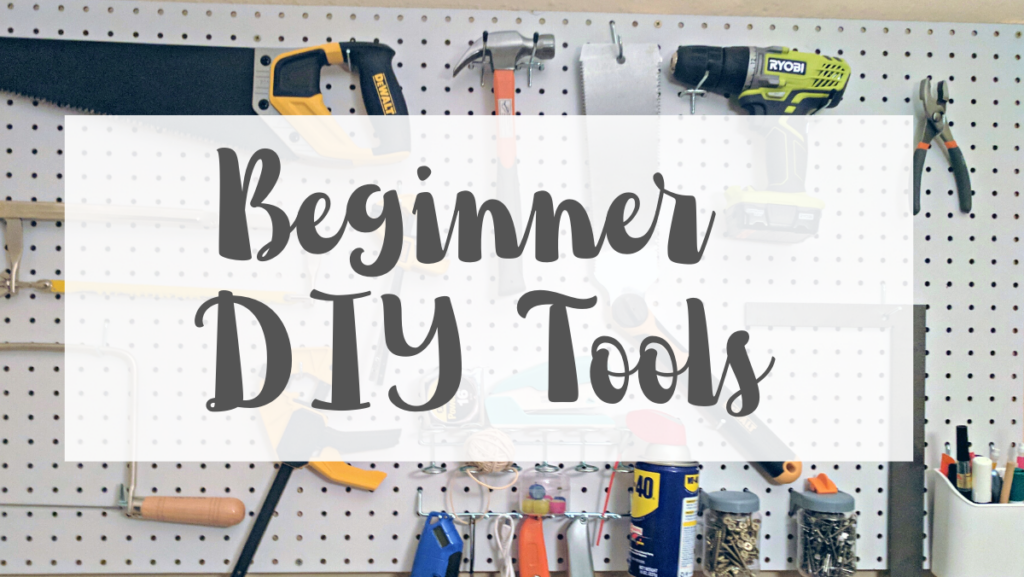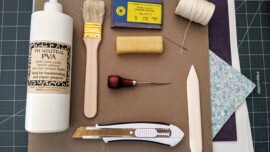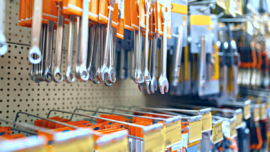If you’re a beginner at DIY projects, you probably need to get your hands on a few tools! Especially if you’re on a budget or don’t have lots of space, it is important to know what tools are truly essential and what you can wait on. Here are my picks for the best DIY tools for beginners to have on hand!
Heads up! This post contains affiliate links. If you use these links, I earn a commission which helps me make more crafty content. You can read more about affiliates here.

There is lots of advice out there about what power tools you should buy first as a DIY beginner or crafty person. However, I’ve found that power tools are not friendly for all makers’ and crafters’ situations! I’ve been making things for years in various small studio/1-bedroom apartments where I can’t make a ton of noise, and don’t have space to store bulky tools! Plus, tools can get expensive— when you’re just starting out, you probably don’t want to drop a ton of money on tools!
That’s why I’ve put together this list of my tool recommendations for beginner DIYers and makers. This is the complete list of tools I’ve used to do basically all of my projects over the last 5 years. You can do so much with just a few basic tools!
This post is all about the essential tools for DIY beginners!
Must-have DIY Tools for Beginners
1. Cordless Drill & Bit Set
Until very recently, this was the only power tool I owned, and it was all I needed! A cordless drill/driver (as in screwdriver) combo is a major wrist saver. So many DIY projects consist of cutting things apart and screwing them back together– a cordless drill gets you halfway there! You’ll want a cordless drill with a battery charger, a set of drive bits (for driving screws), and a set of drill bits (for making holes). I have had my Ryobi cordless drill for years and it is still serving me well, and although I often misplace the box, I love my DeWalt drill bit set.
You can really get crazy and buy super expensive drills or sets with multiple batteries, but I have found that a small 12-18V drill with one battery is all I need. I strongly recommend going with a true driver/drill combo though! An “electric screwdriver” will not get you very far, and you can’t pre-drill holes with one!
2. General Purpose Toolset
Okay, this is technically more than one tool, but since you buy them as a set I’m counting it! After my drill, my second most used tools come from my “household toolset.” These usually include a hammer, a tape measure, a blunt and needle nose pliers, an adjustable wrench, some screwdrivers and bits, Allen wrenches, and a mini level.
They’re a real all-in-one deal! I use the pliers and hammer all the time on projects, and my drill didn’t come with driver bits so the bits from my toolset get a lot of mileage, too. While the exact set I have isn’t for sale anymore, this one is extremely similar and includes all the pieces I just mentioned.
3. Quality Tape Measure
Your household toolkit probably includes a tape measure, but it’s probably not very good. I find the tapes that come in those kits tend to be one of the weak points– they’re usually plastic and flimsy. High-quality tape measures are not expensive and are very worth the small investment. You’ll be putting your tape measure in all kinds of precarious situations, so you want it one that’s going to last. And if you’re a solo DIYer like me, you want a tape that can lock itself in place and not flop around so you can keep your hands free to do other things!
I use this Stanley PowerLock 16′ tape measure. This is the brand that I always saw around my dad’s workshop (he’s been building houses for almost 40 years, so you know his recommendations are good!) The metal body can stand up to a lot, and the tape itself is very sturdy. I’ve had the same one for probably 6 years and use it all the time, and the locking mechanism is still really strong.
4. Japanese Pull Saw
I’ve had many hand saws in my time, but there’s only one I actually need: a Japanese pull saw. What’s great about these saws is the blade is flexible, so you can maneuver it into tricky places. I bought one for the first time when I needed to cut the shelves of my bookcase to make room for a TV, and I didn’t want to disassemble the whole thing. Unlike other hand saws that cut on a “push” motion, these saws cut on a “pull” motion which I find way easier to use. Many of them are also double-sided, so you can do quick rip or cross cuts with the same blade!
I’ve tried the folding pull saws they sell at Home Depot, and don’t really recommend those– go for a Japanese brand for these! The exact one I have is this Ryoba saw from Woodcraft. If you don’t have a Woodcraft near you, this saw on Amazon is very similar (both in terms of design and price) and is very well-reviewed.
5. Work table
Once you have all your other tools and materials together, you need somewhere to work! For years I used whatever flat surfaces I had already as work tables– my desk, my coffee table, my roommate’s kitchen table. The trouble is, it’s hard to keep from beating those nice tables up when you’re working! Having a dedicated work table has vastly improved my DIY experience, and I wish I’d gotten one sooner!
I recommend this folding work table from Black+Decker. Not only does it fold up pretty flat (I store mine behind a door!), it also can act as a clamp to hold boards while you cut them!
Those are my top recommendations for tools for DIY beginners. I did some pretty complicated projects over the years with just these tools, so I know you can too!
Bonus: Non-Tool Supplies to Keep Around
Bonus section! Here is a quick-and-dirty list of supplies I wouldn’t quite call tools that I neverthless recommend for DIY beginners! These are the little things that are always handy to have on hand for when the creative impulse strikes. I try to keep each of these “in-stock” in my home.
















Leave a Reply